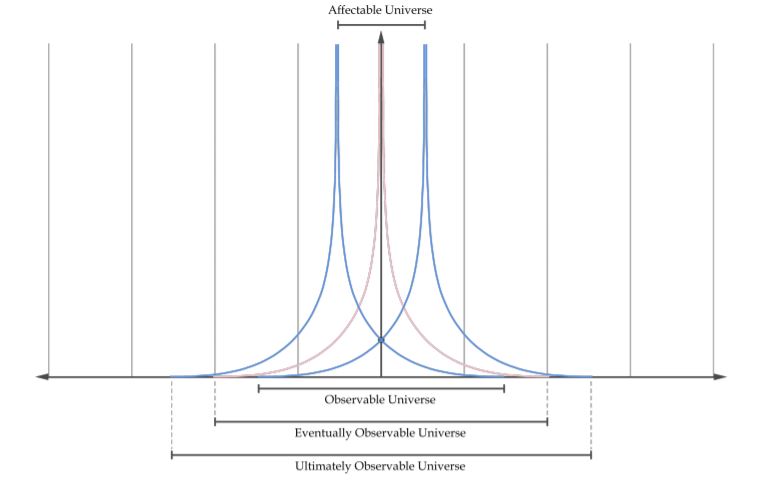Toby Ord’s preprint on the various cosmological scales of interest to expanding interstellar (and intergalactic) Civilizations is well worth pondering: The Edges of the Universe
The usual distance quoted is the Hubble Radius, which doesn’t really have a physical significance in Lambda-Cold Dark Matter cosmologies that are the currently preferred empirical cosmophysics. It does have meaning in the alternate cosmology of R_h=c.t (aka Critical Coasting Cosmology, or w=-1/3) but that requires a different discussion. Ord acknowledges alternate cosmologies, but for this post we’ll stick with the Lambda-CDM cosmology. The unstated assumption is that there’s no FTL physics in the Cosmos, like cosmological wormholes (implying a Multiply Connected Spacetime) or tachyonic particles (which would alter the overall evolution due to negative mass-squared).
So what distance scales are significant? Firstly, these are Radial distances that centre on our place in space-time. Odds are the Whole Universe, if not Infinite, is at least very much larger than the following distances that Ord defines.
Eventually Observable Universe
In infinite time the maximum co-moving distance a photon, starting at the Big Bang, can reach based on present parameters is 62.9 billion light-years. That distance is time dependent and we can presently observe – if we could see past the Big Bang’s Fog – is 46.4 billion light-years away, the (presently) Observable Universe. Eventually, via an asymtotic approach, that Observable distance will expand to 62.9 billion light-years, encompassing within that volume about twice the present visible number of galaxies.
Affectable Universe
The next spherical horizon, like the Observable Universe, starts from Today – some 13.8 Aeons after the Big Bang – and is the distance we can causally influence. Traveling at lightspeed itself, that distance is just 16.5 billion light-years. This is the Affectable Universe. Notice that the Eventually Observable Universe is equal to the sum of the Affectable and Observable. When the Eventually Obervable Universe unveils in the distant future, the Affectable Universe will have shrunk to roughly zero – i.e. our local Group. When the Universe was just 4.1 billion years old, the Affectable and Observable scales coincided.
Ultimately Observable Universe
This final distance is the maximum distance we could in principle have knowledge of… if we rushed out at lightspeed for 16.5 billion years. Thus Eventually Observable Universe plus Affectable Universe – right now, some 79.4 billion light-years away. The reason for this is that the Ultimately Observable Universe centres on one’s current position. Change that position and, in principle, the maximum Cosmic distance can be expanded.

